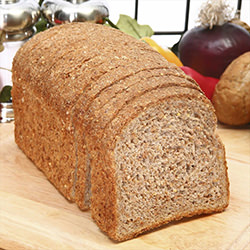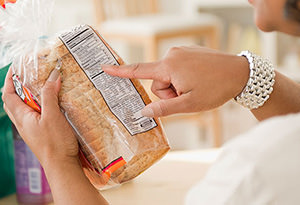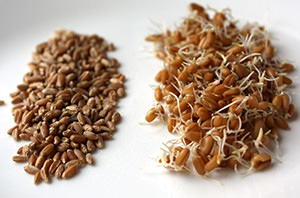
How to Pick the Healthiest Bread
Posted on 07 Feb, 2020

Navigating the bread aisle can be confusing and frustrating. It used to be simple to bring home a loaf. Now it requires concentration, patience and reading glasses! With so many options, that look healthy, how do you choose? To expedite your search, here’s what you need to know.
Choose 100 Percent Whole Grain
Look for 100% whole grain (which means all of the grains are whole). To make sure you are getting 100% whole wheat bread, look at the ingredients list—not the front of the package.
 By law, a food company must list ingredients in descending order based on how much they weigh in the product. This means that the first ingredient is the most prevalent ingredient in the product, and so on. “Whole wheat flour” or “100% whole wheat flour” should be the first ingredient and the only flour listed. Don’t fall for deceitful terms such as “wheat flour,” “unbleached wheat flour,” “multigrain,” “enriched,” or “stone-ground wheat flour.” These are just sneaky ways of saying refined white flour. All grains should have the word "whole" in front of them.
By law, a food company must list ingredients in descending order based on how much they weigh in the product. This means that the first ingredient is the most prevalent ingredient in the product, and so on. “Whole wheat flour” or “100% whole wheat flour” should be the first ingredient and the only flour listed. Don’t fall for deceitful terms such as “wheat flour,” “unbleached wheat flour,” “multigrain,” “enriched,” or “stone-ground wheat flour.” These are just sneaky ways of saying refined white flour. All grains should have the word "whole" in front of them.
NOTE: Why Choose Whole Grains?
You want whole grains because they're naturally low in fat and cholesterol free; contain 10% to 15% protein, and offer loads of healthy fibre, resistant starch, minerals, vitamins, antioxidants, phytochemicals, and often, phytoesterogrens (plant estrogens). Whole grains offer protection from heart disease, stroke, diabetes, obesity, and some cancers.
Look For Bread With 2-3 Grams of Protein
 When examining the nutrition facts, make sure that each slice has 2-3 grams of protein. Protein helps keep us full longer, and it's definitely a macronutrient that we want in bread. Preferably, the protein will be naturally occurring, but some add in soy to boost it and that is ok.
When examining the nutrition facts, make sure that each slice has 2-3 grams of protein. Protein helps keep us full longer, and it's definitely a macronutrient that we want in bread. Preferably, the protein will be naturally occurring, but some add in soy to boost it and that is ok.
Watch The Sodium
 Most bread products come with a dose of sodium, which is added to help control the yeast activity and for flavor. If you eat three servings of whole grain bread a day, and each slice has about 200 milligrams of sodium, that contributes 600 milligrams to your daily sodium total. It may not sound like much, but it represents one-third of your limit if you're trying to stay within 1,800 milligrams a day.
Most bread products come with a dose of sodium, which is added to help control the yeast activity and for flavor. If you eat three servings of whole grain bread a day, and each slice has about 200 milligrams of sodium, that contributes 600 milligrams to your daily sodium total. It may not sound like much, but it represents one-third of your limit if you're trying to stay within 1,800 milligrams a day.
Choose Bread With At Least 3 Grams of Fibre
 Each slice of bread should also has 2-3 grams of fibre. In addition to helping to make us feel full, fibre is also important for maintaining bowel health, controlling blood sugar levels and lowering cholesterol. Carbohydrates are where we consume most of our fibre, so it's very important.
Each slice of bread should also has 2-3 grams of fibre. In addition to helping to make us feel full, fibre is also important for maintaining bowel health, controlling blood sugar levels and lowering cholesterol. Carbohydrates are where we consume most of our fibre, so it's very important.
Keep An Eye On The Sugar
 Yeast needs a little sugar to feed on so it is at times a necessary ingredient in bread. But it shouldn’t contain more than 2-3 grams per slice.
Yeast needs a little sugar to feed on so it is at times a necessary ingredient in bread. But it shouldn’t contain more than 2-3 grams per slice.
Give It A Squeeze
 Give your loaf of bread a gentle squeeze before buying. If it compresses way too easily, keep moving. The denser the bread, the closer you’re getting to the whole grains you want. Truth is manufacturers have a tough time making nourishing bread that’s also soft and fluffy. So sometimes they rely on chemicals, which you also don’t want.
Give your loaf of bread a gentle squeeze before buying. If it compresses way too easily, keep moving. The denser the bread, the closer you’re getting to the whole grains you want. Truth is manufacturers have a tough time making nourishing bread that’s also soft and fluffy. So sometimes they rely on chemicals, which you also don’t want.
- Keep bread in a cool, dry place out of direct sunlight. If you don’t have a bread box, find a cupboard or a nook in the pantry.
- Freeze what you won’t eat within two to three days. French or Italian breads made without any oils have a very short shelf life, so consider freezing them earlier.
- Allow frozen bread to thaw slowly at room temperature. Throw in the oven for 5 minutes before serving. Get ready to eat what you heat, however. Frozen bread dries out quicker than fresh.
- Get the knack for recipes that benefit from slightly stale (four-day-old) bread, such as French toast, grilled cheese sandwiches, and bread pudding.
Opt For Sprouted Breads If They Are Available
 When grains are sprouted, starches and proteins are converted into smaller molecules that are easier to digest. That means sprouted breads offer more essential amino acids, minerals, and B vitamins than standard whole-grain varieties. Also, the usable iron is higher in sprouted breads, thanks to phytase, an enzyme activated during the sprouting process that breaks down a powerful iron blocker found in intact grains. Ounce for ounce, sprouts are the most nutritious of all foods. A sprouted grain has become, in effect, a vegetable.
When grains are sprouted, starches and proteins are converted into smaller molecules that are easier to digest. That means sprouted breads offer more essential amino acids, minerals, and B vitamins than standard whole-grain varieties. Also, the usable iron is higher in sprouted breads, thanks to phytase, an enzyme activated during the sprouting process that breaks down a powerful iron blocker found in intact grains. Ounce for ounce, sprouts are the most nutritious of all foods. A sprouted grain has become, in effect, a vegetable.
Watch Out For Fillers and Sweeteners
 All you really need to make bread is flour, water, yeast, salt, and a little bit of sugar (to activate the yeast). But breads these days have extra ingredients to help improve the taste, texture, shelf life or nutritional profile of the bread. Some fiber-rich additions (like processed oat, cottonseed, pea or wheat fibers) boost the fiber content. Other manufacturers use high fructose corn syrup replaces sugar in many breads to reduce cost and prolong shelf life. And many breads are enriched with vitamins and minerals so that they’ll appear to be more nutritious.
All you really need to make bread is flour, water, yeast, salt, and a little bit of sugar (to activate the yeast). But breads these days have extra ingredients to help improve the taste, texture, shelf life or nutritional profile of the bread. Some fiber-rich additions (like processed oat, cottonseed, pea or wheat fibers) boost the fiber content. Other manufacturers use high fructose corn syrup replaces sugar in many breads to reduce cost and prolong shelf life. And many breads are enriched with vitamins and minerals so that they’ll appear to be more nutritious.
It's up to every individual consumer to decide whether they want a bread that contains corn syrup, preservatives, or other additives. But one thing we could all do is look for breads that have shorter ingredients lists and recognizable ingredients in general.
Photo Credits
Some Great Books For Eating Healthy

by Michael Pollan

by Robin Jeep

by Michael Greger

by Thug Kitchen

 14 Creepy Ways What You Wear Could Be Hurting Your Health
14 Creepy Ways What You Wear Could Be Hurting Your Health Which Is Healthier? Red Or White Onions
Which Is Healthier? Red Or White Onions Are eggs good or bad for you? The final verdict
Are eggs good or bad for you? The final verdict Food Labelling Traps To Avoid
Food Labelling Traps To Avoid










